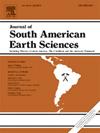Neoproterozoic magmatic arcs of the Araçuaí-Ribeira Orogenic system (AROS), Brazil
IF 1.7
4区 地球科学
Q3 GEOSCIENCES, MULTIDISCIPLINARY
引用次数: 0
Abstract
The last three decades of research within the Araçuaí-Ribeira Orogen (AROS) has provided new field, geochronology, isotopic and geochemical data that reveal a protracted and diachronous tectonic evolution. The two magmatic arc systems IMAS (Inner Magmatic Arc System) and OMAS (Outer Magmatic Arc System) were detected along the AROS, with some important differences along strike are attributed the previous paleogeography characterized by a V-shape Ocean, with two branches that progressively enlarge southwards. The IMAS is the internal continental magmatic arc developed on a continental block of predominantly Rhyacian age, but displaying Archean inheritance. It is a very long ca. 2000 km tectonic block with possibly differences in basement constitution that could have played a role in the heterogeneity of the arc related magmatism. In the Ribeira Orogen, U-Pb ages constrain the ca. 670-620 Ma of the maximum peak of arc magmatism, although a few Cryogenian ages that appear in parts of the IMAS may suggest that convergence could have started before. However, in the Araçuaí/Northern Ribeira Orogen, closure of the precursor basin gulf occurred much later, with 635-585 Ma tonalites and granodiorites of the Rio Doce magmatic arc, with main U-Pb peak of ages around 590 Ma and syn-collisional metamorphic peak at 580-565 Ma. Metamorphic ages constrain the collision of IMAS against São Francisco craton reworked margin between ca. 620-595 Ma. The contrasting OMAS system is detected in the central part of AROS, between the IMAS and the African derived blocks, i.e., in the Cabo Frio terrane and Luis Alves craton. The OMAS testify to a long period of convergence that resulted on two magmatic stages and related basins: ca. 860-760 Ma and 670-620 Ma. The geochemical and isotopic data of these two stages indicate a progressive continentalization of the arc, that have evolved from a very primitive intra-oceanic setting (advancing stage) to a more evolved setting with increase in the contamination by subducted metasedimentary rocks and the cannibalization of the deep parts of arc itself. Finally, some important open questions for future investigations are discussed.

求助全文
约1分钟内获得全文
求助全文
来源期刊

Journal of South American Earth Sciences
地学-地球科学综合
CiteScore
3.70
自引率
22.20%
发文量
364
审稿时长
6-12 weeks
期刊介绍:
Papers must have a regional appeal and should present work of more than local significance. Research papers dealing with the regional geology of South American cratons and mobile belts, within the following research fields:
-Economic geology, metallogenesis and hydrocarbon genesis and reservoirs.
-Geophysics, geochemistry, volcanology, igneous and metamorphic petrology.
-Tectonics, neo- and seismotectonics and geodynamic modeling.
-Geomorphology, geological hazards, environmental geology, climate change in America and Antarctica, and soil research.
-Stratigraphy, sedimentology, structure and basin evolution.
-Paleontology, paleoecology, paleoclimatology and Quaternary geology.
New developments in already established regional projects and new initiatives dealing with the geology of the continent will be summarized and presented on a regular basis. Short notes, discussions, book reviews and conference and workshop reports will also be included when relevant.
 求助内容:
求助内容: 应助结果提醒方式:
应助结果提醒方式:


